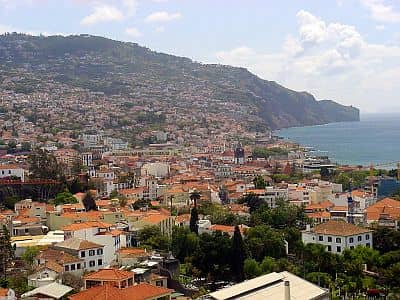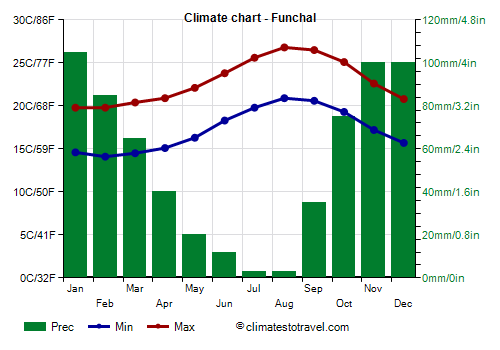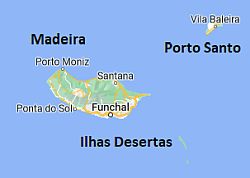Select units of measurement for the temperature and rainfall tables (metric or imperial).
Average weather, temperature, rainfall, sunshine
Madeira, an island in the Atlantic Ocean belonging to Portugal, has a
very mild climate, so much so that it can be considered as the island of eternal spring.
On the coast, daytime
temperatures hover around 20/21 degrees Celsius (68/70 °F) from December to April, and reach 26/27 °C (79/81 °F) from July to September.
Rainfall is concentrated in the period from October to mid-April, when it is quite frequent, while in summer, it is very rare, especially on the southern side.
The north-east
trade winds, which prevail throughout the year, bring a bit of cloudiness, humidity, and rainfall on the north-facing slopes. On the other hand, in the cold half of the year, the islands can be affected by Atlantic depressions, which bring rains everywhere.
Because of the trade winds, the northern side is rainier and windier than the southern one, where the landscape is more arid.

In the interior of the island, we find
hills and mountains. The highest peak is Pico Ruivo, 1,862 meters (6,109 feet) high.
Of course, temperatures decrease with altitude. In the mountains, especially above 1,500 meters (5,000 feet), snowfall and frost can occur in winter. The record is -9.5 °C (15 °F), recorded in Bica da Cana, at 1,580 meters (5,185 ft), in March 1993.
On the northern side and in the mountains, the
wind can be strong, and can sometimes reach 100 kph (60 mph). On the other hand,
Funchal, the capital, on the southern slope, is quite sheltered from the wind.
The interior can be covered by a layer of
fog or low clouds.
In the period from June to October, Madeira can be affected by the
Leste, a hot, dry wind blowing from the Sahara, which can raise the temperature and bring a fine red powder.
The climate in detail
Temperature and rain
Funchal

In
Funchal, the average temperature of the coldest month (February) is of 17 °C (62.5 °F), that of the warmest month (August) is of 23.8 °C (74.9 °F). The data is collected at the airport, which is located on the coast, however, the city climbs hills up to an altitude of 800 meters (2,600 ft), and higher neighborhoods are cooler and cloudier.
It rarely gets cold, however, from January to March there can be cool days, with highs around 15 °C (59 °F). The coldest record in Funchal is 7.5 °C (45.5 °F), set in March 2011, when snowfalls occurred in inland areas above 500 meters (1,650 feet).
Even when the wind blows from Africa, typically the temperature does not exceed 32 °C (89.5 °F), however, the heat record at Funchal airport is 37 °C (98.5 °F), recorded in September 1988 and in July 2012.
In Funchal, annual rainfall is around 640 mm (25 in).
The amount of
sunshine is acceptable in winter, when there is an alternation between sunny periods and bad weather periods, while it's good (but not great) in the summer months.
In June, a blanket of clouds, called
capacete ("helmet") often forms, which covers the island in the early morning but thins out during the warmest hours. However, even in midsummer,
cloud banks can form on the Atlantic Ocean and affect the island, although generally it does not rain.
In total, there are 2,165 hours of sunshine per year.
 Porto Santo, where is located
Porto Santo, where is located
To the north-east of Madeira we find the island of
Porto Santo, smaller and more arid, while to the south-east we find the Desert Islands (
Ilhas Desertas), even smaller and characterized by a rocky soil.
Sea temperature
The temperature of the
sea in Madeira is not very high. In fact, it goes from 18 °C (64.5 °F) between February and April to 23.5 °C (74 °F) in September, and can be considered high enough for swimming from August to October.
When to go
Given that it has a very mild climate, Madeira can be visited
all year round, but from mid-October to mid-April, there may be rains and thunderstorms, while the coolest period is from December to April.
So, the best time is the
summer, from July to September, since it is the warmest, the sunniest and the most recommended for swimming and sunbathing. However, flower and nature lovers will prefer the
spring.
What to pack
In
winter: bring spring/autumn clothes, a sweater, a jacket, a raincoat or umbrella. When climbing Pico Ruivo, a down jacket, a hat, gloves, hiking shoes.
In
summer: bring light clothing, but also a scarf for the wind, a sweatshirt or sweater, a light jacket for the evening. When climbing Pico Ruivo, sunglasses, sunscreen, hiking shoes, a sweatshirt and a jacket for the evening.
Climate data - Madeira
| Funchal |
|---|
|
| Jan | Feb | Mar | Apr | May | Jun | Jul | Aug | Sep | Oct | Nov | Dec |
|---|
| Min temp. | 15 | 14 | 14 | 15 | 16 | 18 | 20 | 21 | 21 | 19 | 17 | 16 |
|---|
| Max temp. | 20 | 20 | 20 | 21 | 22 | 24 | 26 | 27 | 26 | 25 | 23 | 21 |
|---|
| Precip. | 105 | 85 | 65 | 40 | 20 | 10 | 5 | 5 | 35 | 75 | 100 | 100 |
|---|
| Prec. days | 12 | 11 | 10 | 8 | 5 | 3 | 1 | 2 | 6 | 9 | 11 | 13 |
|---|
|
| Day length | 10 | 11 | 12 | 13 | 14 | 14 | 14 | 13 | 12 | 11 | 10 | 10 |
|---|
| Sun hours | 5 | 5 | 6 | 6 | 7 | 5 | 7 | 8 | 7 | 6 | 5 | 5 |
|---|
| Sea temp | 19 | 18 | 18 | 18 | 19 | 21 | 22 | 23 | 24 | 23 | 21 | 20 |
|---|
| Porto Santo |
|---|
|
| Jan | Feb | Mar | Apr | May | Jun | Jul | Aug | Sep | Oct | Nov | Dec |
|---|
| Min temp. | 14 | 13 | 14 | 14 | 16 | 18 | 19 | 20 | 20 | 18 | 16 | 15 |
|---|
| Max temp. | 18 | 18 | 19 | 20 | 21 | 23 | 24 | 26 | 25 | 24 | 21 | 19 |
|---|
| Precip. | 50 | 40 | 35 | 25 | 15 | 5 | 5 | 5 | 25 | 40 | 50 | 70 |
|---|
| Prec. days | 6 | 5 | 6 | 4 | 2 | 1 | 0 | 1 | 2 | 5 | 6 | 7 |
|---|
|
| Day length | 10 | 11 | 12 | 13 | 14 | 14 | 14 | 13 | 12 | 11 | 10 | 10 |
|---|
| Sun hours | 4 | 5 | 6 | 6 | 7 | 7 | 7 | 8 | 7 | 6 | 5 | 4 |
|---|
| Sea temp | 19 | 18 | 18 | 18 | 19 | 21 | 22 | 23 | 24 | 23 | 21 | 20 |
|---|